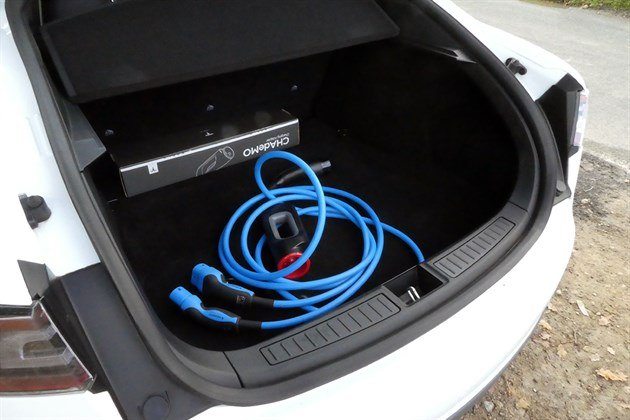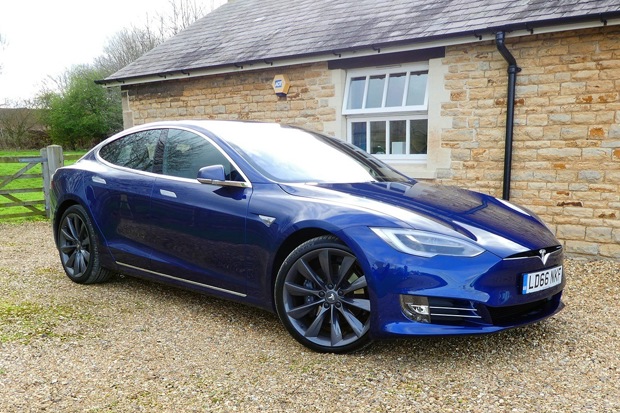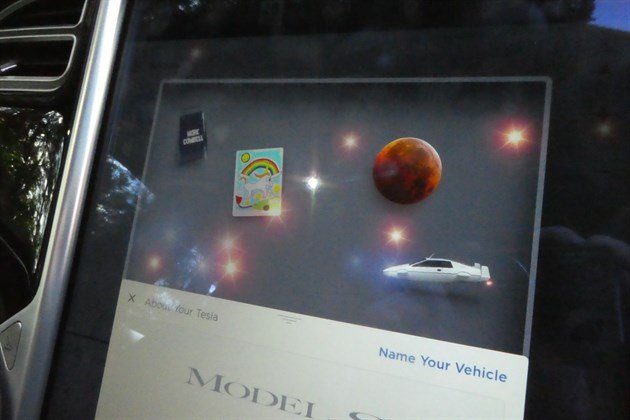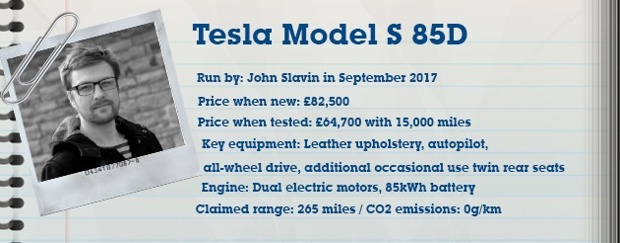Welcome, used Model S
We're spending a few weeks with an approved-used Tesla Model S. It's £17,000 cheaper than it was new - but is it a good buy?

Date: 29 September 2017 | Current mileage: 15,010 | Costs: £7.50 for Ecotricity hook-up
It’s fair to say the Tesla Model S is the ultimate electric car. Superb performance, incredible technology, plenty of battery range and enough space for a family combine to make it a great all-rounder – if you have the cash. But, right now, the start price for a Model S is just over £64,000. Not cheap.
That gets you a 75 with rear-wheel drive. Want all-wheel drive? Then you’ll need to spend just shy of £76,100. That’s where a used Tesla starts to look like a more tempting purchase – a 2015 85D, with all-wheel drive and just under 29,000 miles costs from around £53,000. That’s for a pre-facelift car, but the great thing about a Tesla is the updates.
Over WiFi, improvements to the touchscreen system, ‘Autopilot’ and even the performance and battery system can be applied – so even in a two-year-old car you’ll have some of the most advanced in-car technology in the world. Options that can't be downloaded off the internet include the additional fold-out rear seats, which are included on this example.
So what’s the catch? Well that’s what I decided to find out, by spending three weeks with an approved-used, 65-plate Model S 85D. ‘My’ car cost £82,500 new and is finished in white. Now it has 15,000 miles on the clock and a used price of £64,700. It wears its mileage reasonably well, though as with any used car there are a few little scuffs here and there, on the footplate and metal door trims for example.

In the handover bay at Tesla HQ
No issues with the driving experience though. The Model S detects when you’re nearby (via the keyfob) and unlocks itself, then you simply get in, choose Drive on the gear selector and go. There is no ignition, no start button, nor any handbrake to operate. And then you get superb performance and excellent refinement - read our full review here.
Passing slow traffic is effortless and since this a dual-motor model it has all-wheel drive, so there is huge grip under acceleration and through bends. This two-year old car displays a range of more than 200 miles in the dashboard when charged to 80 per cent - and that feels realistic, especially when cruising on the motorway.
Another important feature that’s present, correct and works beautifully in this Model S is ‘autopilot’. It’s not exactly a true automatic system, but on a motorway cruise it steers, maintains a safe distance to the car in front and will even assist with lane changes. It effectively drives itself in traffic jams too and works wonderfully – but you do need hands on the wheel at all times.
Because it's approved used this Model S has a four-year, 50,000 mile warranty too - just like a brand new Tesla. Over the next few weeks I’m going to try and live with the Model S as if it was any other car. How will it cope with long trips? Is it easy to find a place to charge? Is anything missing from the experience because it’s a couple of years old? And does it really work on UK roads?
Is it easy to keep a Model S charged?
Spending more time with an EV means learning about chargers. Does a Tesla give you range anxiety?

Date: 6 October 2017 | Current mileage: 15,202 | Costs: £15 for Ecotricity hook-up
The big issue for most prospective electric car buyers is charging. Having a battery range of more than 200 miles is great, but if there’s nowhere to plug in and top up then life is going to be quite difficult – and if you have a look at Tesla’s growing supercharger network on a map, you’ll see some big gaps.
One of those gaps is where our office is – and we don’t (yet) have a charging station in the car park, nor do any of the staff at HonestJohn.co.uk have any chargers at home. Which should leave us in a pickle, but actually hasn’t at all – there are now enough EV chargers around the country and our local area to travel without too much range anxiety.
Most of the chargers on the motorway network are provided by Ecotricity and live in motorway service stations. Unless you use Ecotricity as your home energy supplier, it costs around £8 to plug into the fast charger at our local service station for 45 minutes, which adds roughly 100 miles to the range.
In petrol engine terms that’s the cost equivalent of about 65 miles to the gallon. We also found several other chargers locally in Peterborough, including 32A outlets in the shopping centre that are completely free to use. Not bad – but obviously it’s much cheaper and less of a hassle to have a fast charger at home or at work.

The charge leads take up space since underfloor storage is taken up by an extra pair of seats
When we get around to installing our own fast charger at the office, living day-to-day with an EV will be no hassle at all – but what about longer trips? This is where the technology and impressive range of a Tesla come into their own. The P85D I’m driving can travel for more than 200 miles between charges.
That means it can get from the office near Peterborough to London and back again without visiting a charging station. But the Tesla’s huge touchscreen system is keen to make sure you don’t take too many risks and, if it thinks you might get low on battery, it will automatically do its best to take you to a Tesla Supercharger en-route.
These are easier to use than any other chargers – simply hold the connector near the charge port and it opens automatically, then when you hook it up it starts to charge immediately. You can monitor the charge from a phone app, so you can find a coffee shop or place to eat and only head back to the car when it’s topped up.
Obviously, that’s a slower process than simply filling up with diesel, but if you’re driving long distance, a rest break is more or less essential anyway. The only problem is coverage – there are lots of Superchargers in the south, but go to Wales or the North and you’ll struggle. Other chargers are available though and more are being added almost daily.
New vs used - what's changed?
Our Model S was built before a mid-life facelift - so what's missing?

Date: 13 October 2017 | Current mileage: 15,297 | Costs: £7.50 for Ecotricity hook-up
I’m spending a few weeks with a used Tesla Model S, specifically a 65-plate 85D. Obviously the Model S is still for sale – but it has been revised since ‘my’ car was initially built. The biggest changes came in mid-2016 with new front-end styling the most obvious - you can see the facelifted car above.
The newer Model S also has smart LED headlights and better in-cabin storage – our car simply has a big, flat, open tray between the front-seat passengers, rather than closable storage bins. There’s also a new filtration system for the air-conditioning that gets rid of almost all nasty particulates – which is ideal for driving in congested, dirty cities.
But that’s about it. Instead of going all-out with a mid-life update, the Tesla way is constant improvement – usually over the air while you’re sleeping. You might find a software tweak has improved the range of the car by 10 miles, or that you have a new application in the touchscreen system, or the air conditioning is more efficient.
And that’s perhaps why we were so intrigued to try a used Model S. Most of the time, used cars feel dated when you get into them, even if they’re just a couple of years old. That’s not the case with the Model S though – it feels, those few features notwithstanding – just as high-tech as a new one.

Our Model S has no centre console storage - just a big tray
A new one that’s a bit worn in places though. As we mentioned in the first update, there are scuffs here and there – as you’d expect. But that leads on to one of the common complaint areas across all Tesla models – build quality. Compared to a similarly priced BMW or Mercedes-Benz, the Tesla just isn’t quite there.
The shut lines and panel gaps are never quite perfectly aligned on any Tesla we’ve seen, while the cabin has a few materials that just don’t feel up to the standards set by German rivals. It’s not bad – and the space-age layout does offset some of those problems – but there’s no denying it could be better.
Despite this, everyone who has spent any time in the Model S since it was delivered - whether as a driver or passenger - has only had good things to say. It’s refreshingly different from the usual. You don’t get millions of buttons in the centre stack, you don’t get an awkward transmission tunnel and the touchscreen is slick and uncluttered.
It feels different. And because of that it feels special in a way that few cars ever do, whether they’re big expensive supercars or luxury saloons. It attracts so much positive attention too, and that’s despite the “old” 65-plate adorning its not-facelifted nose.
So... should you buy one?
Our time's up. Do we want to send the Tesla back or keep it forever?

Date: 20 October 2017 | Current mileage: 15,483 | Costs: £7.50 for Ecotricity hook-up
Now we’re nearing the end of our time with the Model S, it’s time to decide if buying one used is a good idea. But first, a criticism that’s become clearer the longer we’ve spent with the Model S – it’s seriously wide. So much so that narrow lanes and parking spaces are tricky.
Parking at the office is no problem and charging points usually have very large spaces too – but visit a supermarket car park and it’s pretty tricky to squeeze in and out of the car unless you park at the far end away from everyone else. It’s clear this was a car designed for wide American streets and parking lots.
Still, its width led to a very ‘Tesla’ moment. I came back to the car, which was plugged in at a multi-storey car park, to find another Tesla parked precariously close. But the driver of that car had kindly left a note, explaining that if our car’s summon feature wasn’t working we could call him and he’d come and get out of the way.
Fortunately, there was enough space to get in without calling him or even using summon – which slowly edges the car out of its space automatically – so it was all fine. But it was nice to see a bit of Tesla community spirit – which is another reason we’re glad we had the chance to spend more than just a few days with the Model S.

Little features like a secret menu of fun extra features make the Model S feel 'special'
In fact, that little experience encapsulated the feeling of driving a Tesla beautifully – it makes you and other people feel good. We didn’t have any sneering or insults, like you sometimes get in an exotic supercar – just thumbs up, smiles and loads of questions and compliments.
You have to make a few changes and sacrifices to live with an EV – even a Tesla – but after a few weeks and the odd trip to a charge point I’m used to them. You need to plan trips in advance if they’re long, but I’m not sure I’d need a second, petrol-powered car alongside the Tesla if I had to live with it permanently.
Its range, long-distance comfort and ease-of use really do offset the need to stop now and then for a 30-minute fast charge. But obviously there’s a premium to pay for such an impressive car if you go for a new one, particularly a dual-motor one like ours – which is why we’ve been testing a used, £64,700 one.
That’s still a lot. But a few odd areas of wear aside, it doesn’t feel like it lacks anything essential over a new Model S – so if you’re dreaming of a Tesla but your budget doesn’t permit a new one – give the used car a chance. After a few weeks, I can’t think of any major downside. Since it's approved used it has a full warranty for four years – and a £17,000 saving versus new is a major upside.


